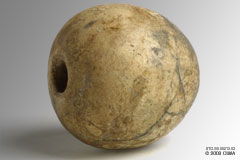Macehead, Merimde, c. 5100 BC

Links to other views:⇒ Larger Viewif scripting is off, click the ⇒ instead. Links to others from Predynastic PeriodFish cosmetic palette, 4000-3500 BCMacehead, Merimde, c. 5100 BC Prehistoric axe, Merimde, c. 5100 BC22 Shells amulet-pendant, c. 4500 BC Links to others of type MaceMacehead, Merimde, c. 5100 BC |
This ceremonial or votive macehead was made in Merimde, Egypt around 5100 BC. Mace-head A mace is a basic hand-held weapon, half-way between a club and a hammer. Egyptian maces generally consisted of a heavy spherical or apple-shaped stone head affixed on a stout wooden handle. Although maces may or may not have been in fact a weapon of choice for Egyptian warriors and soldiers, they soon became symbols of military might. Indeed, Egyptian iconography is rife with depictions of Egyptian leaders smiting enemies with a mace, and some of the earliest tangible documentation of Dynastic Egypt was provided by ceremonial mace-heads, such as that of King Scorpion and King Narmer of Dynasty 1. Bibliography (for this item)Hoffman, Michael A.1991 Egypt Before the Pharaohs: The Prehistoric Foundations of Egyptian Civilization. 2nd edition. University of Texas Press, Austin, TX. (173, 178, fig. 48 173-181) |